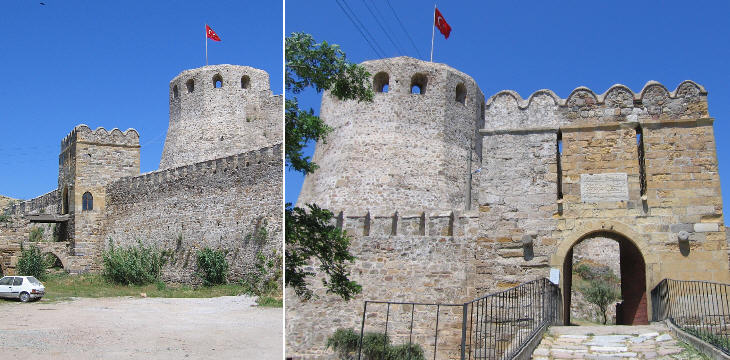  What's New! Detailed Sitemap All images © by Roberto Piperno, owner of the domain. Write to romapip@quipo.it. Text edited by Rosamie Moore. Page added in July 2006. |
  Tenedo Tenedo(detail of an Ottoman miniature showing Rumeli Kavagi, a lost fortress on the Bosporus) Tenedo (Bozcaada) is a small island very near the Asian entrance to the Dardanelles. It played an important role during the War of Troy; after ten years of useless siege, the Greeks abandoned their camp and put their ships out to sea. According to the traditional account they left a gigantic wooden horse on the beach, an offering to Athene to gain her help in safely returning home. The Greek ships however had not sailed towards their towns; they had just hidden behind Tenedos; at a given signal from one of the men who had entered Troy (inside the wooden horse), Agamennon ordered the Greek ships to drive shoreward.
Several centuries later Tenedos was at the centre of another war: the War of Tenedo (1378-81) between Genoa and Venice (also known as the War of Chioggia). The Byzantine Emperor John V imprisoned and blinded his own son Andronicus, who managed to escape with the help of the Genoese and to dethrone his father. In return for their services he bequeathed Tenedo to them: he disregarded the fact that six years earlier the island had become a Venetian base following an agreement between John V and Venice. The Venetian governor of Tenedo repelled the Genoese when they tried to enforce their rule on the island. The war was eventually fought in Italy and its initial cause was almost forgotten. In the peace treaty both Genoa and Venice gave up their rights to Tenedo.
Tenedo eventually became an Ottoman possession, but its limited fortifications allowed the Venetians to raid the island in 1500. Venice occupied the island in a more permanent way during the early years of the war of Candia (1645-69). Tenedo with nearby Imbro served as a supply base for the Venetian fleet which blocked the Dardanelles. During this period the Venetians improved the fortifications protecting the harbour of the island.
The current imposing aspect of the fortress is the result of extensive improvements made by the Ottomans after 1657 (the year they managed to dislodge the Venetians from the Dardanelles).
Similar to what occurred on other islands, the Ottomans occupied the area protected by the walls around the fortress. The Greeks, who constituted the majority of the population, lived outside the fortified town.
As a consequence of the events which followed WWI, Tenedo was assigned to Greece and a few years later returned to the control of Turkey. In this context the buildings inside the walls were abandoned and only a few tombs and inscriptions of the old town remain.
The tense relations between Greece and Turkey led many Greeks to leave Tenedo. In recent years a more constructive approach has led to a desire to forget the conflicts of the past: in June 2006 in the former Greek quarter a church was being restored and the use of Greek made a timid appearance.
Fortresses of the Sultans - Introduction Fortresses built before 1453: 1 - Anadolu Hisar 2 - Rumeli Hisar Fortresses built after 1453 and before 1657: 3 - Kale Sultanieh 4 - Kilitbahir Fortresses built after 1657: 5 - Seddulbahir 6 - Imbro 7 - Tenedo Clickable Map of the Ionian and Aegean Seas with links to other locations covered in this website (opens in a separate window) |






